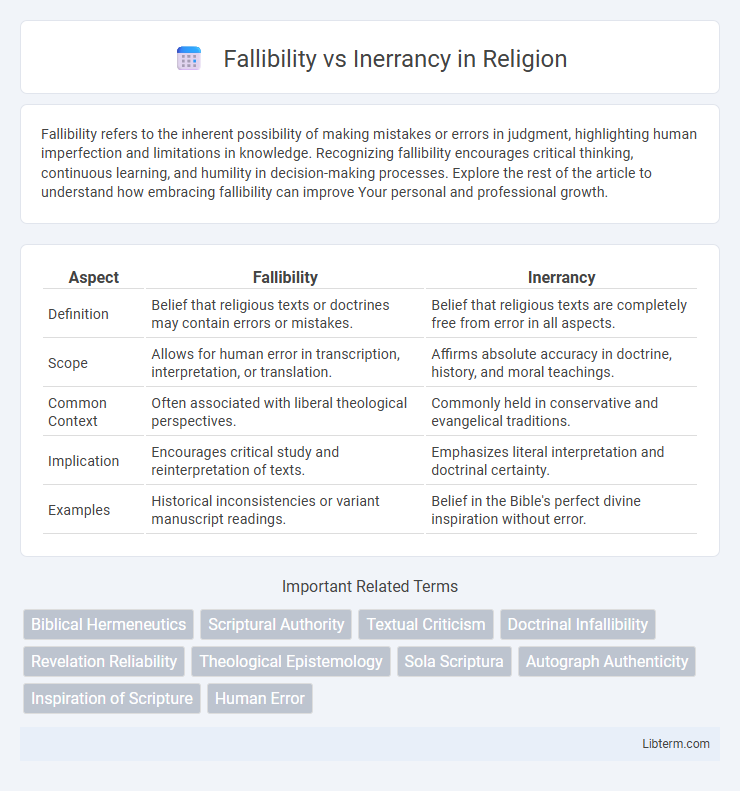Fallibility refers to the inherent possibility of making mistakes or errors in judgment, highlighting human imperfection and limitations in knowledge. Recognizing fallibility encourages critical thinking, continuous learning, and humility in decision-making processes. Explore the rest of the article to understand how embracing fallibility can improve Your personal and professional growth.
Table of Comparison
| Aspect | Fallibility | Inerrancy |
|---|---|---|
| Definition | Belief that religious texts or doctrines may contain errors or mistakes. | Belief that religious texts are completely free from error in all aspects. |
| Scope | Allows for human error in transcription, interpretation, or translation. | Affirms absolute accuracy in doctrine, history, and moral teachings. |
| Common Context | Often associated with liberal theological perspectives. | Commonly held in conservative and evangelical traditions. |
| Implication | Encourages critical study and reinterpretation of texts. | Emphasizes literal interpretation and doctrinal certainty. |
| Examples | Historical inconsistencies or variant manuscript readings. | Belief in the Bible's perfect divine inspiration without error. |
Understanding Fallibility and Inerrancy
Fallibility refers to the inherent possibility of making errors or mistakes in human knowledge and understanding, highlighting that human cognition is not flawless. Inerrancy denotes the belief that certain texts, such as religious scriptures, are entirely free from error in their original manuscripts and teachings. Understanding the distinction between fallibility and inerrancy is crucial for interpreting authoritative sources and assessing the reliability of information.
Historical Roots of the Debate
The debate between fallibility and inerrancy has deep historical roots tracing back to early Christian theological discussions on the nature of Scripture and divine inspiration. The Reformation period intensified this discourse, with figures like Martin Luther emphasizing Scripture's authority while acknowledging human limitations, contrasting with later movements that asserted biblical inerrancy as doctrinal orthodoxy. Scholarly works from the Enlightenment further shaped perspectives by introducing critical methods that questioned the text's absolute accuracy, framing the ongoing tension between recognizing human error and maintaining scriptural perfection.
Scriptural Perspectives on Error
Scriptural perspectives on error reveal a spectrum between fallibility, acknowledging human susceptibility to mistakes, and inerrancy, asserting the Bible's complete freedom from error in its original manuscripts. Various theological traditions emphasize inerrancy to affirm divine inspiration and trustworthiness of all biblical teachings, while acknowledging human fallibility highlights the role of interpretation and transmission errors. The debate impacts hermeneutics, doctrinal formulation, and how believers engage with scripture in faith and practice.
Key Arguments for Inerrancy
Inerrancy asserts that the Bible is without error in all its teachings and historical accounts, grounded in the belief that divine inspiration ensures complete truthfulness. Key arguments emphasize the coherence and consistency of Scripture, asserting that contradictions are interpretative errors rather than flaws in the text itself. Advocates argue that the moral and prophetic accuracy demonstrated throughout the Bible supports its divine origin and infallible authority.
Key Arguments for Fallibility
Fallibility emphasizes the human capacity to make mistakes, highlighting that knowledge and beliefs are subject to revision based on new evidence or interpretations. Key arguments for fallibility include the recognition of historical errors in scientific theories, the influence of cognitive biases on judgment, and the evolving nature of understanding in disciplines such as theology and philosophy. This perspective fosters critical thinking and continuous inquiry, contrasting with inerrancy's claim of absolute truth and error-free knowledge.
Impact on Theology and Doctrine
Fallibility acknowledges human error in scriptural interpretation and theological formulations, leading to more flexible doctrines that adapt to cultural and historical contexts. Inerrancy upholds the Bible as completely free from error, reinforcing rigid doctrinal stances and influencing conservative theological frameworks. The debate shapes denominational beliefs, affects biblical hermeneutics, and guides the development of systematic theology across Christian traditions.
Implications for Scriptural Interpretation
The debate between fallibility and inerrancy fundamentally shapes scriptural interpretation by determining the extent to which texts are viewed as free from error. Embracing inerrancy leads to a literal approach, asserting that Scripture is without any factual or doctrinal mistakes, thereby influencing doctrinal formulations and theological conclusions. Conversely, recognizing fallibility allows for human elements within the biblical texts, encouraging contextual analysis and critical engagement with historical and cultural factors in interpretation.
Modern Controversies and Discussions
Modern controversies surrounding fallibility versus inerrancy primarily center on biblical interpretation and doctrinal authority within religious communities. Scholars debate whether sacred texts contain human errors or are completely free from mistakes, influencing theological stances and faith practices. This discourse impacts contemporary hermeneutics, church teachings, and inter-denominational dialogues.
Balancing Faith and Critical Inquiry
Balancing faith and critical inquiry requires understanding the distinction between fallibility and inerrancy in religious texts. Fallibility acknowledges human limitations in interpretation and transmission, allowing room for questions and growth in belief. Inerrancy upholds that scriptures are without error, demanding a careful approach to reconcile tradition with modern critical analysis while maintaining spiritual integrity.
Navigating the Path Forward
Navigating the path forward between fallibility and inerrancy requires embracing a balance that acknowledges human limitations while striving for accuracy and truth. Prioritizing critical thinking and open dialogue fosters a culture where errors are examined constructively, promoting continuous improvement. Establishing clear standards for evidence and interpretation can help reconcile differing perspectives and guide informed decision-making.
Fallibility Infographic

 libterm.com
libterm.com